A) The enzymes of species b and f are very similar.
B) The enzymes of species b and c are more similar to ancestor #4 than to ancestor 2
C) The enzymes of species a and b are the same as that of ancestor #2.
D) The enzyme of species c is very similar to that of species d.
Correct Answer

verified
Correct Answer
verified
Multiple Choice
Which of the following statements about horizontal gene transfer is accurate?
A) Horizontal gene transfer was quite common in the early stages of evolution of life on Earth.
B) Horizontal gene transfer among organisms does not occur today.
C) Horizontal gene transfer moves only genes that play a role in metabolism.
D) Horizontal gene transfer occurs only among closely related organisms.
Correct Answer

verified
Correct Answer
verified
Multiple Choice
The following question refers to the following phylogenetic trees.
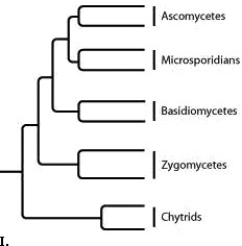
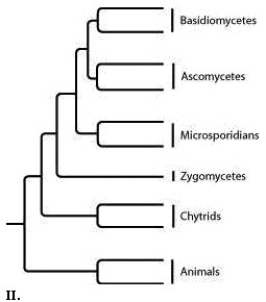
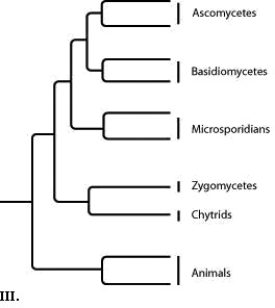
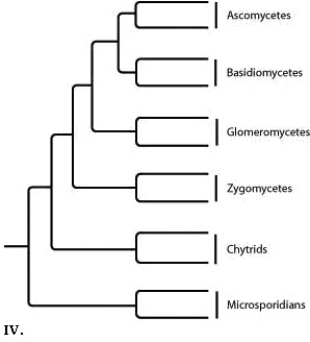 Which tree depicts the closest relationship between zygomycetes and chytrids?
Which tree depicts the closest relationship between zygomycetes and chytrids?
A) I
B) II
C) III
D) IV
Correct Answer

verified
Correct Answer
verified
Multiple Choice
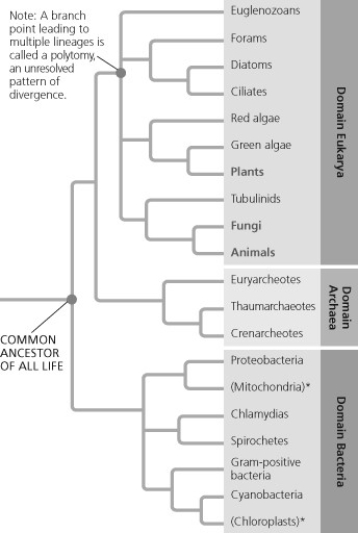 A phylogenetic tree is shown for the three domains of life (Eukarya, Archaea, and Bacteria) . The tree branches in two directions from the first point, labeled Common ancestor of all life. One branch leads in the direction of Eukarya and Archaea, and the other branch leads to Bacteria. The branch leading to Eukarya and Archaea divide, one branch leading to each domain. The branch leading to Eukarya divides into four branches. One leads to Euglenozoans, and the other three lead to branching points. The first leads to Forams in one direction, and another branching point in the other that leads to Diatoms and Ciliates. The second branching point leads to Red algae in one direction, and a branching point that leads to green algae and land plants in the other direction. The third branching point leads to amoebas in one direction, and a branching point that leads to fungi and animals in the other direction. Land plants, Fungi and Animals are all highlighted.
Examine the figure. If you were a graduate student trying to develop a thesis project that would resolve polytomies, which of the following groups would you study?
A phylogenetic tree is shown for the three domains of life (Eukarya, Archaea, and Bacteria) . The tree branches in two directions from the first point, labeled Common ancestor of all life. One branch leads in the direction of Eukarya and Archaea, and the other branch leads to Bacteria. The branch leading to Eukarya and Archaea divide, one branch leading to each domain. The branch leading to Eukarya divides into four branches. One leads to Euglenozoans, and the other three lead to branching points. The first leads to Forams in one direction, and another branching point in the other that leads to Diatoms and Ciliates. The second branching point leads to Red algae in one direction, and a branching point that leads to green algae and land plants in the other direction. The third branching point leads to amoebas in one direction, and a branching point that leads to fungi and animals in the other direction. Land plants, Fungi and Animals are all highlighted.
Examine the figure. If you were a graduate student trying to develop a thesis project that would resolve polytomies, which of the following groups would you study?
A) animals and fungi
B) euglenozoans, euryarcheotes, and gram-positive bacteria
C) forams, red algae, and amoebas
D) red algae, green algae, and cyanobacteria
Correct Answer

verified
Correct Answer
verified
Multiple Choice
Use the following figure and description to answer the question.
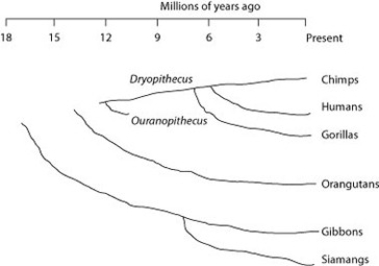 Humans, chimpanzees, gorillas, and orangutans are members of a clade called the great apes, which shared a common ancestor about 15 million years ago. Gibbons and siamangs comprise a clade called the lesser apes. Tree-branch lengths indicate elapsed time.
Assuming chimps and gorillas are humans' closest relatives, removing humans from the great ape clade and placing them in a different clade has the effect of making the phylogenetic tree of the great apes ________.
Humans, chimpanzees, gorillas, and orangutans are members of a clade called the great apes, which shared a common ancestor about 15 million years ago. Gibbons and siamangs comprise a clade called the lesser apes. Tree-branch lengths indicate elapsed time.
Assuming chimps and gorillas are humans' closest relatives, removing humans from the great ape clade and placing them in a different clade has the effect of making the phylogenetic tree of the great apes ________.
A) polyphyletic
B) paraphyletic
C) monophyletic
D) into a new order
Correct Answer

verified
Correct Answer
verified
Multiple Choice
Concerning growth in genome size over evolutionary time, which of these is least associated with the others?
A) orthologous genes
B) gene duplications
C) paralogous genes
D) gene families
Correct Answer

verified
Correct Answer
verified
Multiple Choice
In a comparison of birds and mammals, having four limbs is ________.
A) a shared ancestral character
B) a shared derived character
C) a character useful for distinguishing birds from mammals
D) an example of analogy rather than homology
Correct Answer

verified
Correct Answer
verified
Multiple Choice
Imagine that you discovered the following information:

A) Eukaryotes share a more recent common ancestor with bacteria than with archaea.
B) Bacteria are the only one of the three groups that lacks a nucleus.
C) Archaea are more similar to bacteria than to eukaryotes.
D) Eukaryotes are more similar to archaea than to bacteria.
Correct Answer

verified
Correct Answer
verified
Multiple Choice
Molecular clocks are more reliable when ________.
A) the surrounding pH is close to 7.0
B) most mutations of highly conserved DNA sequences should have no functional effect
C) the DNA codes for amino acid sequences whose side groups (or R groups) have a neutral pH
D) a significant proportion of mutations are not acted upon by natural selection
Correct Answer

verified
Correct Answer
verified
Multiple Choice
Which of the following statements is accurate with regard to a phylogeny, as represented by a phylogenetic tree?
A) Descendant groups (branches) from the same node likely share many derived characters.
B) A monophyletic group can be properly based on convergent features.
C) The ancestral group often has all the derived characters of the descendant species.
D) Shared ancestral characters are excellent traits to use in developing a phylogeny.
Correct Answer

verified
Correct Answer
verified
Multiple Choice
If you were using cladistics to build a phylogenetic tree of cats, which of the following would be the best outgroup?
A) wolf
B) domestic cat
C) lion
D) leopard
Correct Answer

verified
Correct Answer
verified
Multiple Choice
To apply parsimony to constructing a phylogenetic tree,
A) choose the tree that assumes all evolutionary changes are equally probable.
B) choose the tree in which the branch points are based on as many shared derived characters as possible.
C) choose the tree that represents the fewest evolutionary changes, in either DNA sequences or morphology.
D) choose the tree with the fewest branch points.
Correct Answer

verified
Correct Answer
verified
Multiple Choice
If you were using cladistics to build a phylogenetic tree of cats, which of the following would be the best outgroup?
A) lion
B) domestic cat
C) wolf
D) leopard
Correct Answer

verified
Correct Answer
verified
Multiple Choice
If organisms A, B, and C belong to the same class but to different orders and if organisms C, D, and E belong to the same order but to different families, which of the following pairs of organisms would be expected to show the greatest degree of structural homology?
A) A and D
B) B and D
C) B and C
D) D and E
Correct Answer

verified
Correct Answer
verified
Multiple Choice
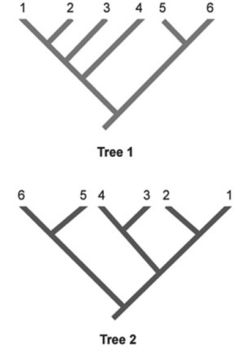 In the phylogenetic trees, numbers represent species, and the same species are shown in both trees. Which two species are represented as sister species in Tree 2 but are not shown as sister species in Tree 1?
In the phylogenetic trees, numbers represent species, and the same species are shown in both trees. Which two species are represented as sister species in Tree 2 but are not shown as sister species in Tree 1?
A) 1 and 2
B) 2 and 3
C) 3 and 4
D) 4 and 5
Correct Answer

verified
Correct Answer
verified
Showing 61 - 75 of 75
Related Exams